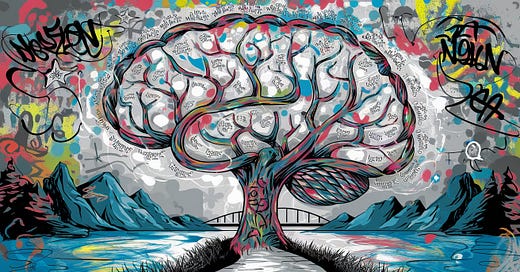Evolving Students' Critical Thinking Skills Through Metacognative Reflection
We don't just ask for reflection, we push them harder and harder
As you know, Eugenia Novokshanova, Ph.D. and I are driven to innovate with AI every time we create an iteration of our writing courses. A little background: our English course requires the students to find a exigent controversy and write an investigative piece about why the controversy exists, what it consists of, and who argues on the different sides of that controversy and why. (We are basing our class on the theories of Gerald Graff in "Teaching the Conflicts" https://lnkd.in/en_f3Hms).
Students write a sustained writing project in three parts:
Exigence of the Controversy,
Context and History of the Controversy, and
Voices of the Controversy.
At the end, they produce a 15-20 page deeply researched investigative paper. It is multimodal with metacognative reflection and a recomposition of their work into a website with the requisite adjustment of their tone and writing technique.
But we do something else--we push them up Bloom's triangle, not only through the assignments themselves, which are challenging, but through their metacognative reflections on those assignments.

One of the repeated assignments we use for each project is the “Mind Map.” This is a visual representation of how the student will organize and present the information in this part of the project.
Metacognative Reflection 1: Remembering and Understanding
Once students complete the Exigence of the Controversy mind map, we require a metacognative reflection of that mind-map, where we query them on successfully organizing information, identifying successes and challenges encountered during the task, and the transferability of knowledge and skills to other academic or real-world contexts. Here’s what the metacognative part of the assignment looked like:
“What was your overall experience of organizing your research information in a mind map? What was successful? What was challenging? What knowledge or skills practiced in this assignment can you transfer to other academic classes or out-of-class writing situations? Use at least ONE very specific example from your experience to illustrate your reflection.”
This initial activity lays the groundwork for the first two levels of Bloom’s Taxonomy: Remembering and Understanding. Students learn fundamental organizational strategies for writing and reflect on their effectiveness.
Metacognative Reflection 2: Applying and Analyizing
During the second part of the project, The Context and History of the Conflict, we have them do a second mind-map. The second part of the project asks them to reflect upon how their approach has evolved from the first assignment, specific strategies or techniques they have adapted or improved, and how these methods can be creatively applied to more complex or interdisciplinary research. Here’s the metacognative part of that assignment:
“Reflecting on your second literature map, how has your approach to organizing and synthesizing research information evolved? What specific strategies or techniques did you adapt or improve the second time, and why? Use at least one detailed example from this map to illustrate your growth and application.How can you creatively expand on these techniques to handle more complex or interdisciplinary research in future academic or real-world scenarios?”
The second metacognative reflection involves Applying and Analyzing: Students refine their approaches, applying them to more complex tasks and analyzing their effectiveness.
Metacognative Reflection 3: Evaluating and Creating
Finally, in stage three, they reflect upon how this process has enhanced their ability to generate new ideas or make connections across diverse sources, and how a novel application for these skills can be applied to non-academic contexts, such as professional or personal projects. Here’s the metacognative part of that assignment:
“As you completed your third and final literature map, think about the broader impact of this process on your ability to generate new ideas or connections across different sources. How did this activity enhance your critical thinking and creativity in synthesizing information? Propose a novel way to use this mapping strategy in a non-academic context, such as professional work or personal projects. Include one specific idea or project where this skill could be impactful.”
The third metacognative reflection involves Evaluating and Creating: Students demonstrate their ability to synthesize ideas and propose innovative applications beyond the classroom.
This approach isn’t limited to this one assignment. As we have carefully updated and evaluated our assignments for this upcoming semester, we have implimented the strategic use of Bloom’s Taxonomy in most of our assigments in the course, including reading.
What we have learned throughout this process is that each iteration of our course becomes more structurally sound as we push to integrate more and more classic educational theory into everything we do with our writing courses. Because we are using so much AI in our courses, our grounding in educational theory becomes more and more important and relevant as we look to balance technology and subject-matter knowledge.







what ecological impacts do you see generative ai having on the critical thinking skills from the bloom's framework? which aspects can be augmented via a generative ai medium and which aspects risk being offloading without intervention?